Project Management Leadership: Skills, Models, and Team Roles Report
VerifiedAdded on 2022/12/27
|20
|5789
|39
Report
AI Summary
This report delves into the core aspects of project management leadership, commencing with an identification of crucial leadership skills essential for project success. It explores the selection and justification of appropriate leadership models, emphasizing the importance of people-based leadership. The report then examines the critical process of linking team roles within a project, highlighting the significance of effective communication, trust-building, and team meetings. It also emphasizes the allocation and recording of team roles. Furthermore, the report proposes the development of a suitable project leadership system, outlining the relevant criterion included in the leadership ranking and its relevance to project leadership theory, followed by a description of the theory. The overall objective is to provide a comprehensive understanding of project leadership, equipping readers with insights into its practical application.
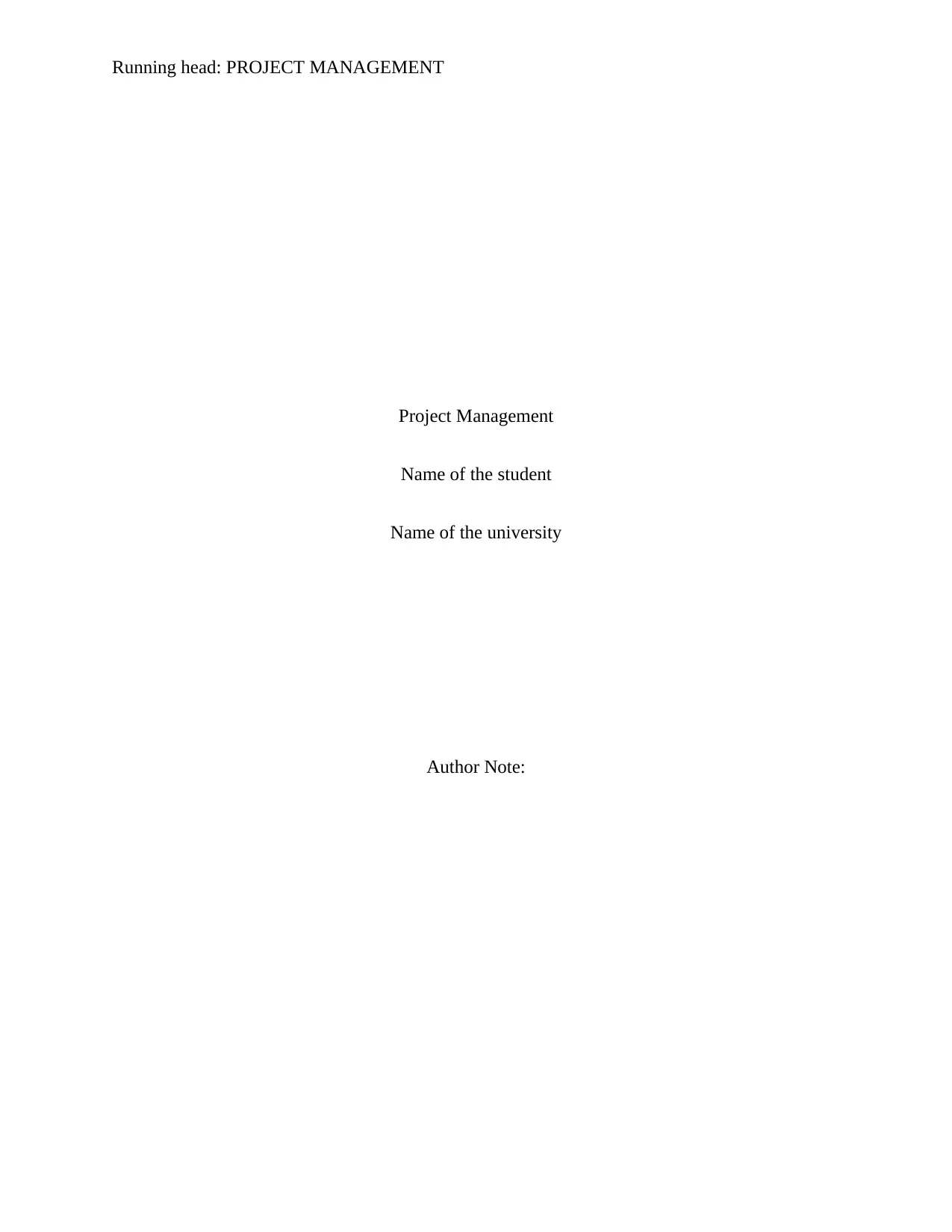
Running head: PROJECT MANAGEMENT
Project Management
Name of the student
Name of the university
Author Note:
Project Management
Name of the student
Name of the university
Author Note:
Paraphrase This Document
Need a fresh take? Get an instant paraphrase of this document with our AI Paraphraser
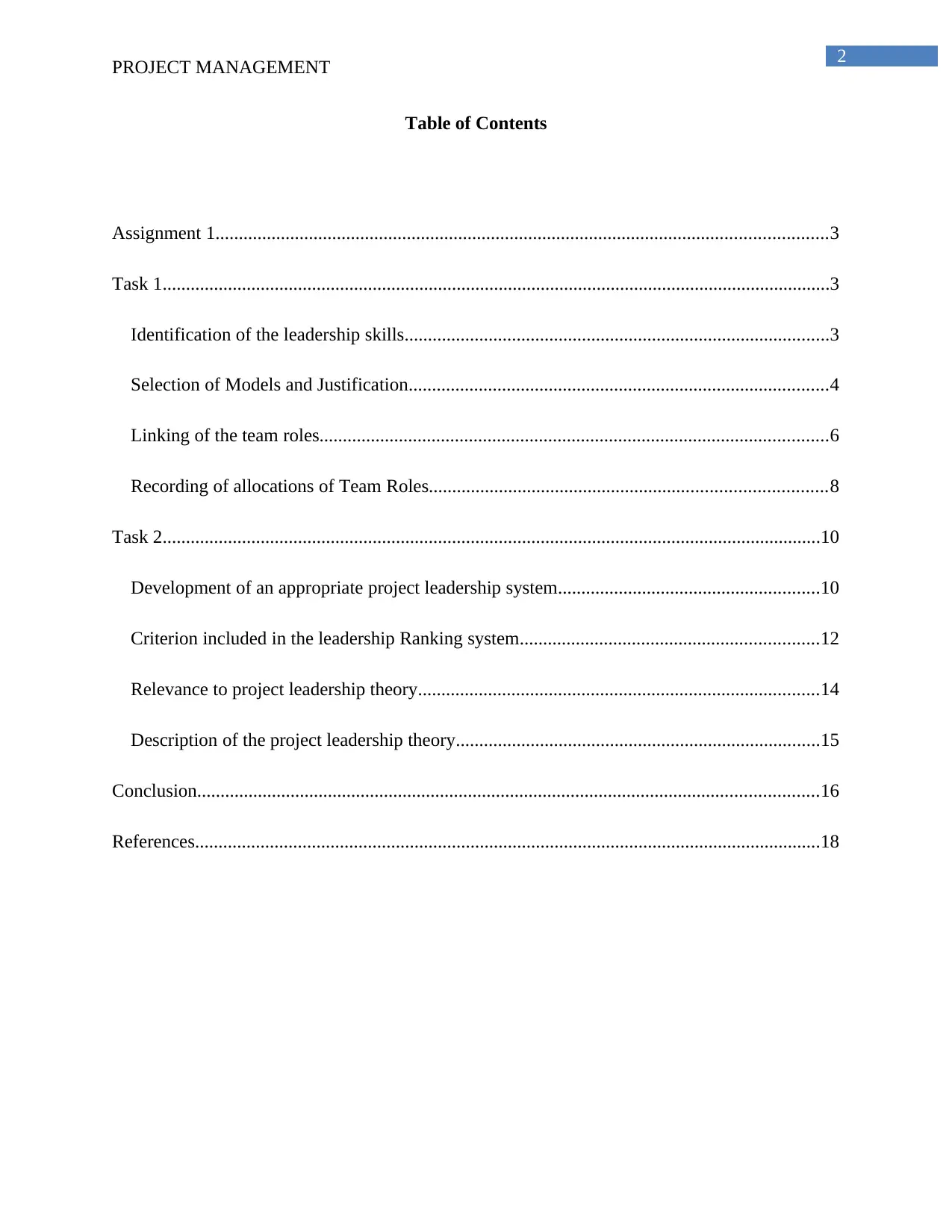
2
PROJECT MANAGEMENT
Table of Contents
Assignment 1...................................................................................................................................3
Task 1...............................................................................................................................................3
Identification of the leadership skills...........................................................................................3
Selection of Models and Justification..........................................................................................4
Linking of the team roles.............................................................................................................6
Recording of allocations of Team Roles.....................................................................................8
Task 2.............................................................................................................................................10
Development of an appropriate project leadership system........................................................10
Criterion included in the leadership Ranking system................................................................12
Relevance to project leadership theory......................................................................................14
Description of the project leadership theory..............................................................................15
Conclusion.....................................................................................................................................16
References......................................................................................................................................18
PROJECT MANAGEMENT
Table of Contents
Assignment 1...................................................................................................................................3
Task 1...............................................................................................................................................3
Identification of the leadership skills...........................................................................................3
Selection of Models and Justification..........................................................................................4
Linking of the team roles.............................................................................................................6
Recording of allocations of Team Roles.....................................................................................8
Task 2.............................................................................................................................................10
Development of an appropriate project leadership system........................................................10
Criterion included in the leadership Ranking system................................................................12
Relevance to project leadership theory......................................................................................14
Description of the project leadership theory..............................................................................15
Conclusion.....................................................................................................................................16
References......................................................................................................................................18
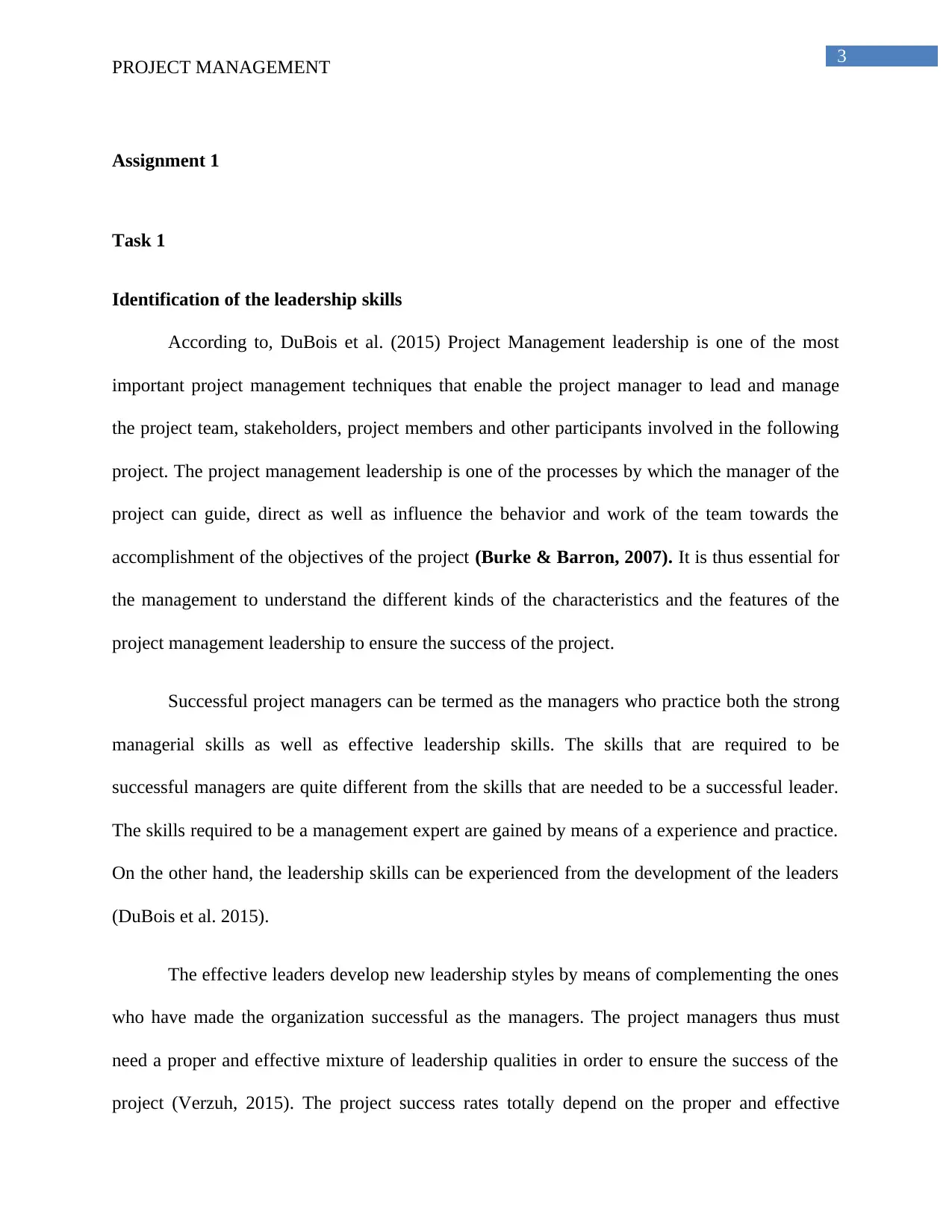
3
PROJECT MANAGEMENT
Assignment 1
Task 1
Identification of the leadership skills
According to, DuBois et al. (2015) Project Management leadership is one of the most
important project management techniques that enable the project manager to lead and manage
the project team, stakeholders, project members and other participants involved in the following
project. The project management leadership is one of the processes by which the manager of the
project can guide, direct as well as influence the behavior and work of the team towards the
accomplishment of the objectives of the project (Burke & Barron, 2007). It is thus essential for
the management to understand the different kinds of the characteristics and the features of the
project management leadership to ensure the success of the project.
Successful project managers can be termed as the managers who practice both the strong
managerial skills as well as effective leadership skills. The skills that are required to be
successful managers are quite different from the skills that are needed to be a successful leader.
The skills required to be a management expert are gained by means of a experience and practice.
On the other hand, the leadership skills can be experienced from the development of the leaders
(DuBois et al. 2015).
The effective leaders develop new leadership styles by means of complementing the ones
who have made the organization successful as the managers. The project managers thus must
need a proper and effective mixture of leadership qualities in order to ensure the success of the
project (Verzuh, 2015). The project success rates totally depend on the proper and effective
PROJECT MANAGEMENT
Assignment 1
Task 1
Identification of the leadership skills
According to, DuBois et al. (2015) Project Management leadership is one of the most
important project management techniques that enable the project manager to lead and manage
the project team, stakeholders, project members and other participants involved in the following
project. The project management leadership is one of the processes by which the manager of the
project can guide, direct as well as influence the behavior and work of the team towards the
accomplishment of the objectives of the project (Burke & Barron, 2007). It is thus essential for
the management to understand the different kinds of the characteristics and the features of the
project management leadership to ensure the success of the project.
Successful project managers can be termed as the managers who practice both the strong
managerial skills as well as effective leadership skills. The skills that are required to be
successful managers are quite different from the skills that are needed to be a successful leader.
The skills required to be a management expert are gained by means of a experience and practice.
On the other hand, the leadership skills can be experienced from the development of the leaders
(DuBois et al. 2015).
The effective leaders develop new leadership styles by means of complementing the ones
who have made the organization successful as the managers. The project managers thus must
need a proper and effective mixture of leadership qualities in order to ensure the success of the
project (Verzuh, 2015). The project success rates totally depend on the proper and effective
⊘ This is a preview!⊘
Do you want full access?
Subscribe today to unlock all pages.

Trusted by 1+ million students worldwide
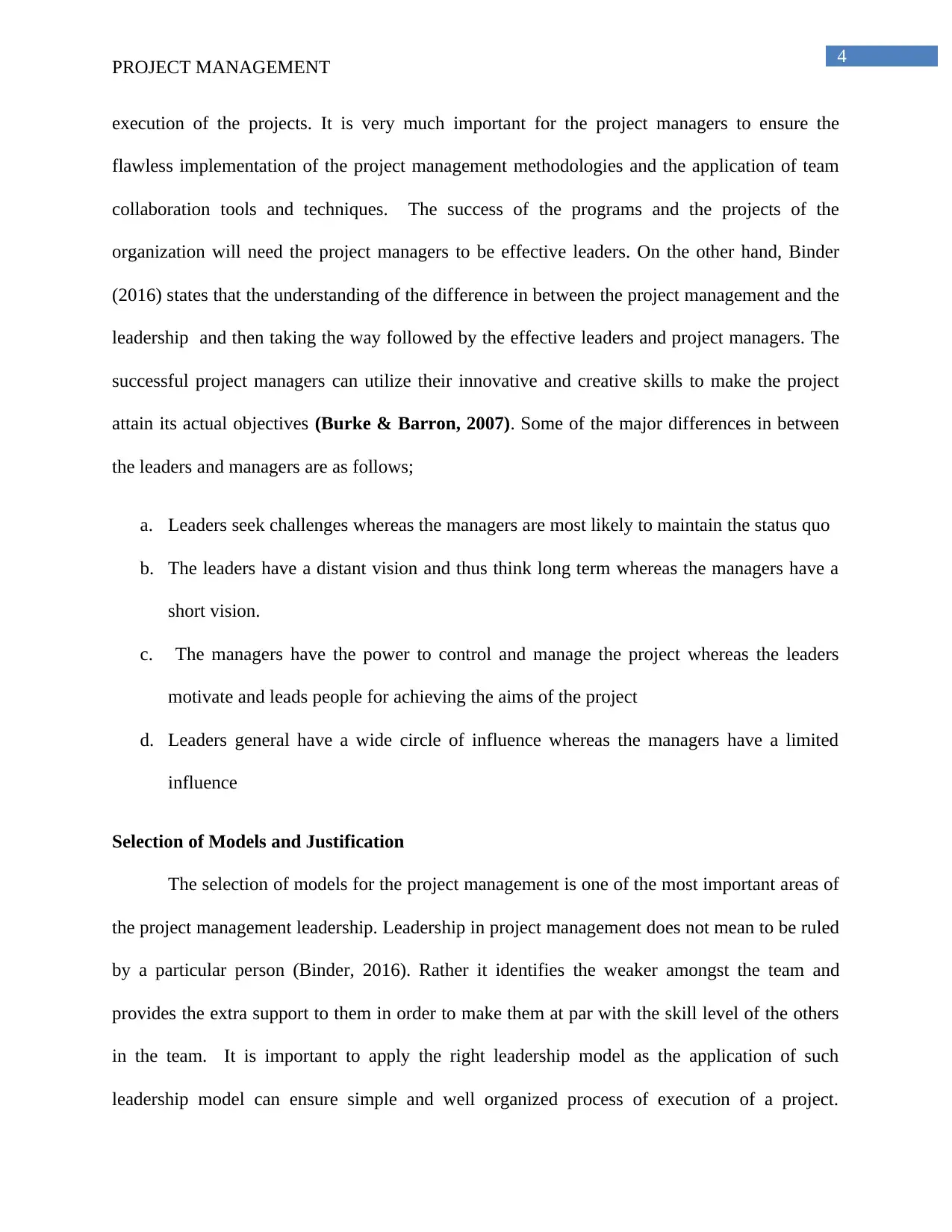
4
PROJECT MANAGEMENT
execution of the projects. It is very much important for the project managers to ensure the
flawless implementation of the project management methodologies and the application of team
collaboration tools and techniques. The success of the programs and the projects of the
organization will need the project managers to be effective leaders. On the other hand, Binder
(2016) states that the understanding of the difference in between the project management and the
leadership and then taking the way followed by the effective leaders and project managers. The
successful project managers can utilize their innovative and creative skills to make the project
attain its actual objectives (Burke & Barron, 2007). Some of the major differences in between
the leaders and managers are as follows;
a. Leaders seek challenges whereas the managers are most likely to maintain the status quo
b. The leaders have a distant vision and thus think long term whereas the managers have a
short vision.
c. The managers have the power to control and manage the project whereas the leaders
motivate and leads people for achieving the aims of the project
d. Leaders general have a wide circle of influence whereas the managers have a limited
influence
Selection of Models and Justification
The selection of models for the project management is one of the most important areas of
the project management leadership. Leadership in project management does not mean to be ruled
by a particular person (Binder, 2016). Rather it identifies the weaker amongst the team and
provides the extra support to them in order to make them at par with the skill level of the others
in the team. It is important to apply the right leadership model as the application of such
leadership model can ensure simple and well organized process of execution of a project.
PROJECT MANAGEMENT
execution of the projects. It is very much important for the project managers to ensure the
flawless implementation of the project management methodologies and the application of team
collaboration tools and techniques. The success of the programs and the projects of the
organization will need the project managers to be effective leaders. On the other hand, Binder
(2016) states that the understanding of the difference in between the project management and the
leadership and then taking the way followed by the effective leaders and project managers. The
successful project managers can utilize their innovative and creative skills to make the project
attain its actual objectives (Burke & Barron, 2007). Some of the major differences in between
the leaders and managers are as follows;
a. Leaders seek challenges whereas the managers are most likely to maintain the status quo
b. The leaders have a distant vision and thus think long term whereas the managers have a
short vision.
c. The managers have the power to control and manage the project whereas the leaders
motivate and leads people for achieving the aims of the project
d. Leaders general have a wide circle of influence whereas the managers have a limited
influence
Selection of Models and Justification
The selection of models for the project management is one of the most important areas of
the project management leadership. Leadership in project management does not mean to be ruled
by a particular person (Binder, 2016). Rather it identifies the weaker amongst the team and
provides the extra support to them in order to make them at par with the skill level of the others
in the team. It is important to apply the right leadership model as the application of such
leadership model can ensure simple and well organized process of execution of a project.
Paraphrase This Document
Need a fresh take? Get an instant paraphrase of this document with our AI Paraphraser
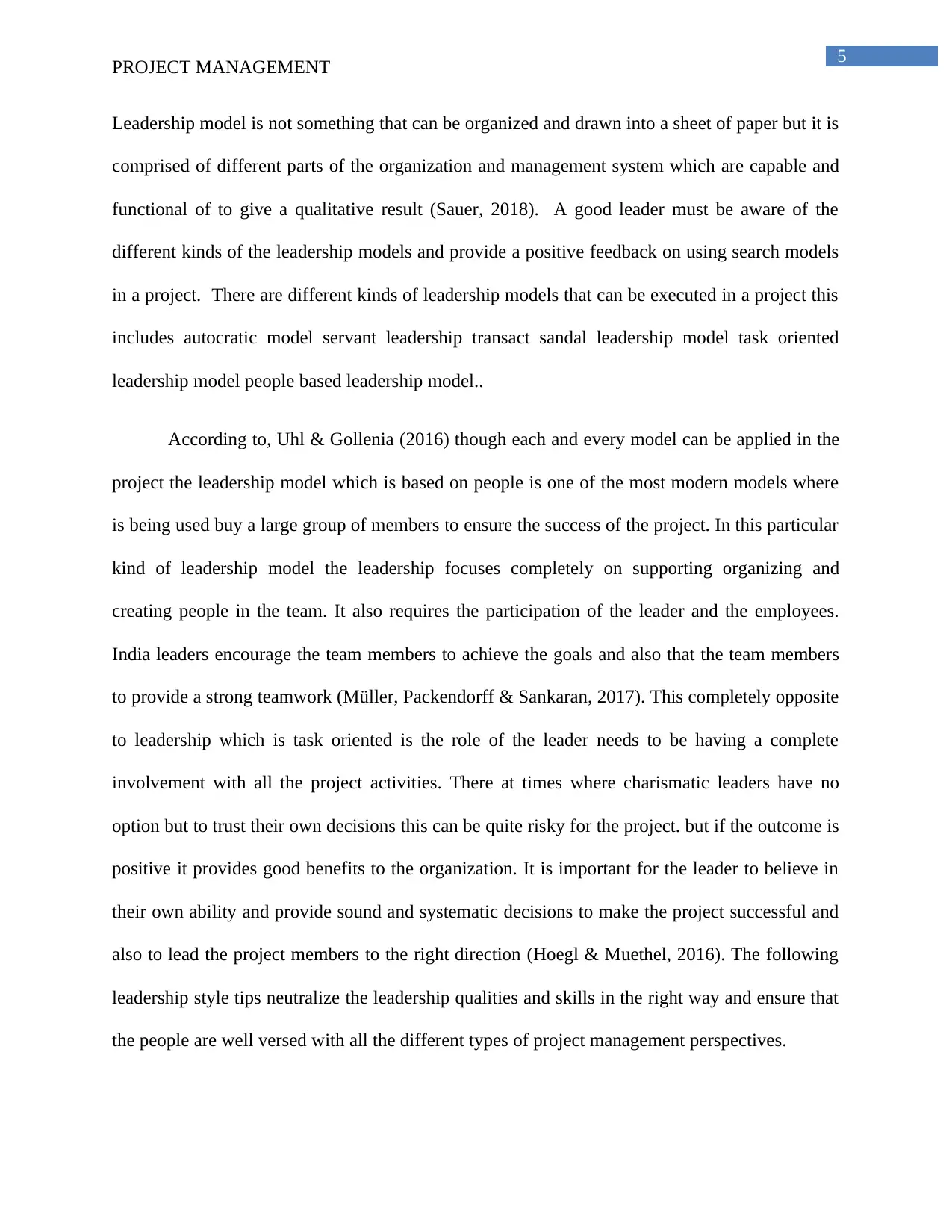
5
PROJECT MANAGEMENT
Leadership model is not something that can be organized and drawn into a sheet of paper but it is
comprised of different parts of the organization and management system which are capable and
functional of to give a qualitative result (Sauer, 2018). A good leader must be aware of the
different kinds of the leadership models and provide a positive feedback on using search models
in a project. There are different kinds of leadership models that can be executed in a project this
includes autocratic model servant leadership transact sandal leadership model task oriented
leadership model people based leadership model..
According to, Uhl & Gollenia (2016) though each and every model can be applied in the
project the leadership model which is based on people is one of the most modern models where
is being used buy a large group of members to ensure the success of the project. In this particular
kind of leadership model the leadership focuses completely on supporting organizing and
creating people in the team. It also requires the participation of the leader and the employees.
India leaders encourage the team members to achieve the goals and also that the team members
to provide a strong teamwork (Müller, Packendorff & Sankaran, 2017). This completely opposite
to leadership which is task oriented is the role of the leader needs to be having a complete
involvement with all the project activities. There at times where charismatic leaders have no
option but to trust their own decisions this can be quite risky for the project. but if the outcome is
positive it provides good benefits to the organization. It is important for the leader to believe in
their own ability and provide sound and systematic decisions to make the project successful and
also to lead the project members to the right direction (Hoegl & Muethel, 2016). The following
leadership style tips neutralize the leadership qualities and skills in the right way and ensure that
the people are well versed with all the different types of project management perspectives.
PROJECT MANAGEMENT
Leadership model is not something that can be organized and drawn into a sheet of paper but it is
comprised of different parts of the organization and management system which are capable and
functional of to give a qualitative result (Sauer, 2018). A good leader must be aware of the
different kinds of the leadership models and provide a positive feedback on using search models
in a project. There are different kinds of leadership models that can be executed in a project this
includes autocratic model servant leadership transact sandal leadership model task oriented
leadership model people based leadership model..
According to, Uhl & Gollenia (2016) though each and every model can be applied in the
project the leadership model which is based on people is one of the most modern models where
is being used buy a large group of members to ensure the success of the project. In this particular
kind of leadership model the leadership focuses completely on supporting organizing and
creating people in the team. It also requires the participation of the leader and the employees.
India leaders encourage the team members to achieve the goals and also that the team members
to provide a strong teamwork (Müller, Packendorff & Sankaran, 2017). This completely opposite
to leadership which is task oriented is the role of the leader needs to be having a complete
involvement with all the project activities. There at times where charismatic leaders have no
option but to trust their own decisions this can be quite risky for the project. but if the outcome is
positive it provides good benefits to the organization. It is important for the leader to believe in
their own ability and provide sound and systematic decisions to make the project successful and
also to lead the project members to the right direction (Hoegl & Muethel, 2016). The following
leadership style tips neutralize the leadership qualities and skills in the right way and ensure that
the people are well versed with all the different types of project management perspectives.
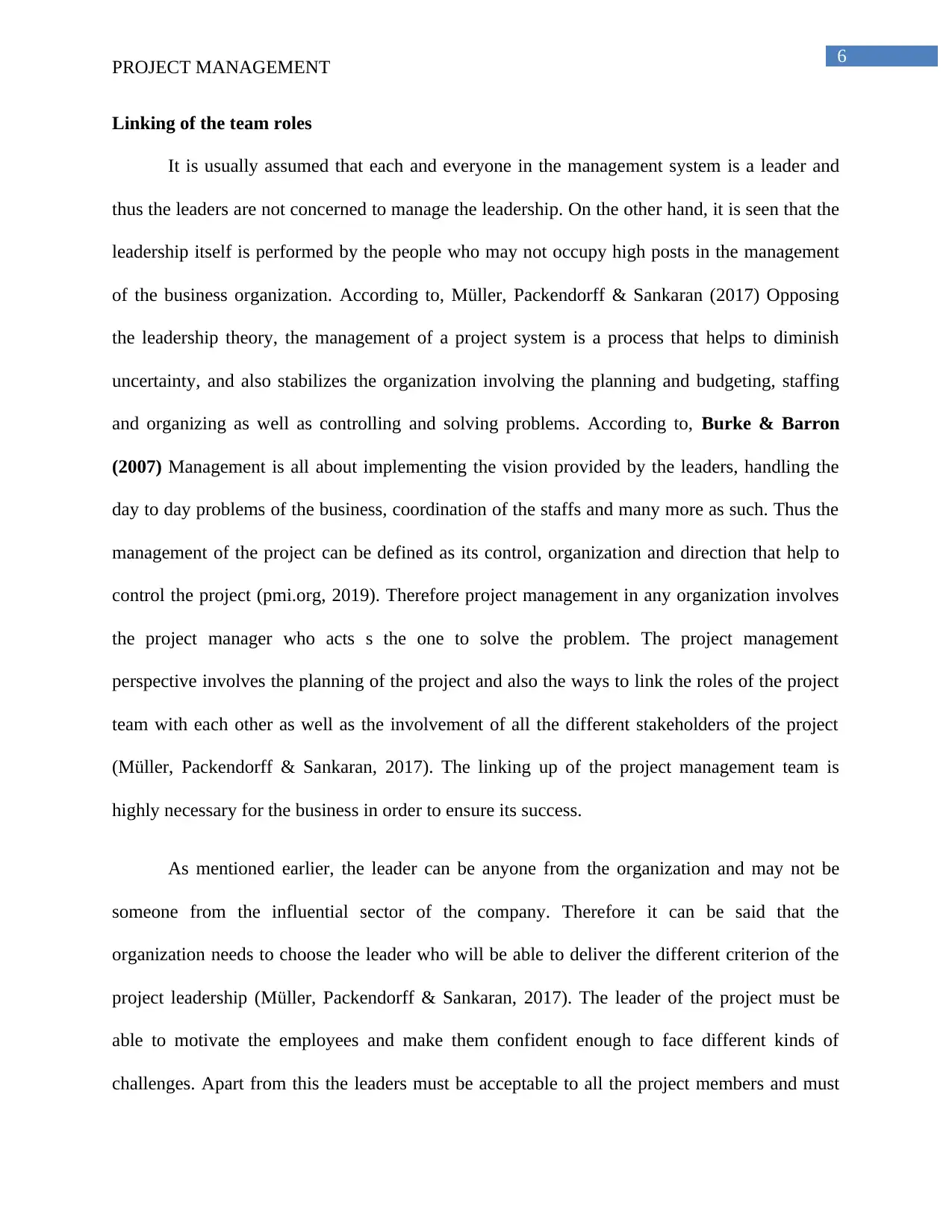
6
PROJECT MANAGEMENT
Linking of the team roles
It is usually assumed that each and everyone in the management system is a leader and
thus the leaders are not concerned to manage the leadership. On the other hand, it is seen that the
leadership itself is performed by the people who may not occupy high posts in the management
of the business organization. According to, Müller, Packendorff & Sankaran (2017) Opposing
the leadership theory, the management of a project system is a process that helps to diminish
uncertainty, and also stabilizes the organization involving the planning and budgeting, staffing
and organizing as well as controlling and solving problems. According to, Burke & Barron
(2007) Management is all about implementing the vision provided by the leaders, handling the
day to day problems of the business, coordination of the staffs and many more as such. Thus the
management of the project can be defined as its control, organization and direction that help to
control the project (pmi.org, 2019). Therefore project management in any organization involves
the project manager who acts s the one to solve the problem. The project management
perspective involves the planning of the project and also the ways to link the roles of the project
team with each other as well as the involvement of all the different stakeholders of the project
(Müller, Packendorff & Sankaran, 2017). The linking up of the project management team is
highly necessary for the business in order to ensure its success.
As mentioned earlier, the leader can be anyone from the organization and may not be
someone from the influential sector of the company. Therefore it can be said that the
organization needs to choose the leader who will be able to deliver the different criterion of the
project leadership (Müller, Packendorff & Sankaran, 2017). The leader of the project must be
able to motivate the employees and make them confident enough to face different kinds of
challenges. Apart from this the leaders must be acceptable to all the project members and must
PROJECT MANAGEMENT
Linking of the team roles
It is usually assumed that each and everyone in the management system is a leader and
thus the leaders are not concerned to manage the leadership. On the other hand, it is seen that the
leadership itself is performed by the people who may not occupy high posts in the management
of the business organization. According to, Müller, Packendorff & Sankaran (2017) Opposing
the leadership theory, the management of a project system is a process that helps to diminish
uncertainty, and also stabilizes the organization involving the planning and budgeting, staffing
and organizing as well as controlling and solving problems. According to, Burke & Barron
(2007) Management is all about implementing the vision provided by the leaders, handling the
day to day problems of the business, coordination of the staffs and many more as such. Thus the
management of the project can be defined as its control, organization and direction that help to
control the project (pmi.org, 2019). Therefore project management in any organization involves
the project manager who acts s the one to solve the problem. The project management
perspective involves the planning of the project and also the ways to link the roles of the project
team with each other as well as the involvement of all the different stakeholders of the project
(Müller, Packendorff & Sankaran, 2017). The linking up of the project management team is
highly necessary for the business in order to ensure its success.
As mentioned earlier, the leader can be anyone from the organization and may not be
someone from the influential sector of the company. Therefore it can be said that the
organization needs to choose the leader who will be able to deliver the different criterion of the
project leadership (Müller, Packendorff & Sankaran, 2017). The leader of the project must be
able to motivate the employees and make them confident enough to face different kinds of
challenges. Apart from this the leaders must be acceptable to all the project members and must
⊘ This is a preview!⊘
Do you want full access?
Subscribe today to unlock all pages.

Trusted by 1+ million students worldwide
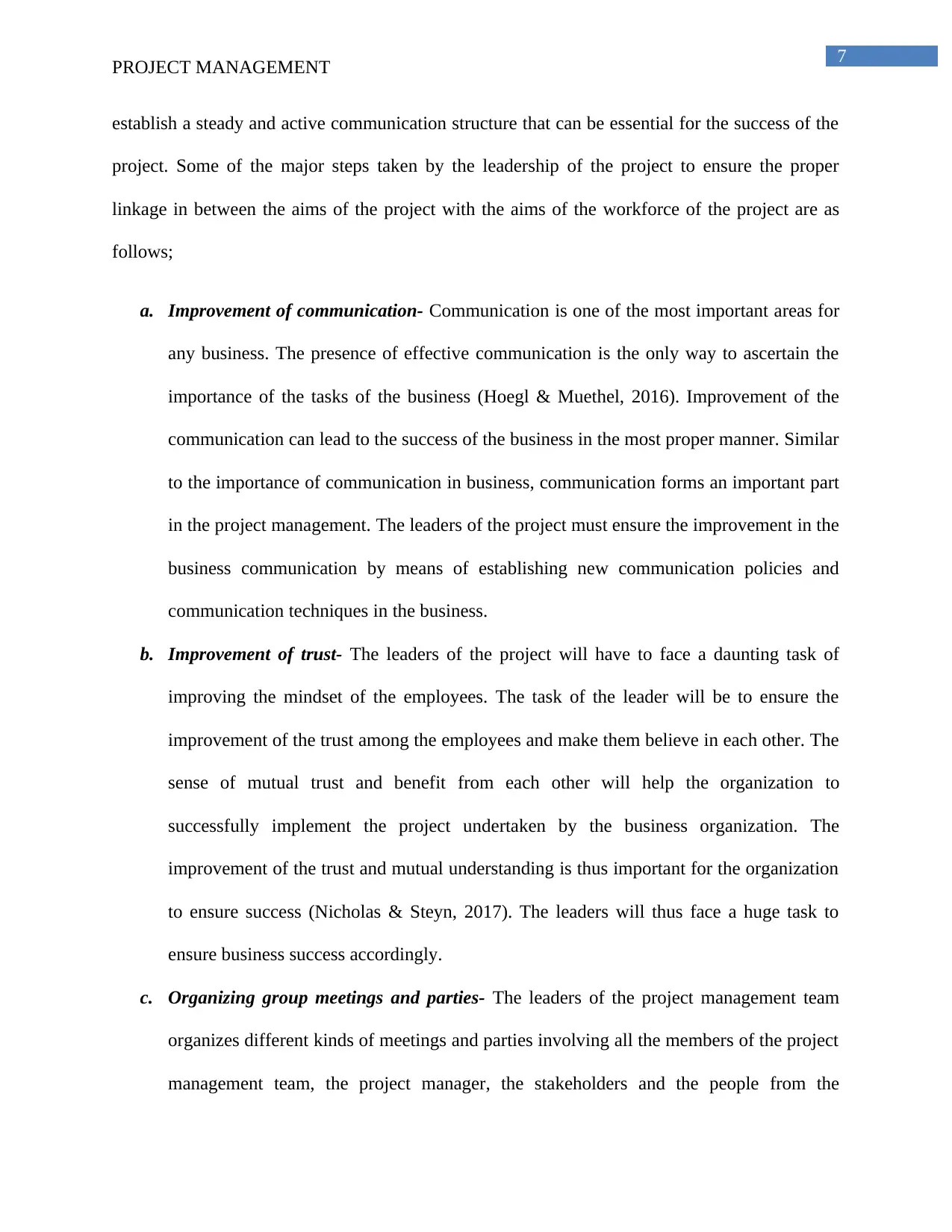
7
PROJECT MANAGEMENT
establish a steady and active communication structure that can be essential for the success of the
project. Some of the major steps taken by the leadership of the project to ensure the proper
linkage in between the aims of the project with the aims of the workforce of the project are as
follows;
a. Improvement of communication- Communication is one of the most important areas for
any business. The presence of effective communication is the only way to ascertain the
importance of the tasks of the business (Hoegl & Muethel, 2016). Improvement of the
communication can lead to the success of the business in the most proper manner. Similar
to the importance of communication in business, communication forms an important part
in the project management. The leaders of the project must ensure the improvement in the
business communication by means of establishing new communication policies and
communication techniques in the business.
b. Improvement of trust- The leaders of the project will have to face a daunting task of
improving the mindset of the employees. The task of the leader will be to ensure the
improvement of the trust among the employees and make them believe in each other. The
sense of mutual trust and benefit from each other will help the organization to
successfully implement the project undertaken by the business organization. The
improvement of the trust and mutual understanding is thus important for the organization
to ensure success (Nicholas & Steyn, 2017). The leaders will thus face a huge task to
ensure business success accordingly.
c. Organizing group meetings and parties- The leaders of the project management team
organizes different kinds of meetings and parties involving all the members of the project
management team, the project manager, the stakeholders and the people from the
PROJECT MANAGEMENT
establish a steady and active communication structure that can be essential for the success of the
project. Some of the major steps taken by the leadership of the project to ensure the proper
linkage in between the aims of the project with the aims of the workforce of the project are as
follows;
a. Improvement of communication- Communication is one of the most important areas for
any business. The presence of effective communication is the only way to ascertain the
importance of the tasks of the business (Hoegl & Muethel, 2016). Improvement of the
communication can lead to the success of the business in the most proper manner. Similar
to the importance of communication in business, communication forms an important part
in the project management. The leaders of the project must ensure the improvement in the
business communication by means of establishing new communication policies and
communication techniques in the business.
b. Improvement of trust- The leaders of the project will have to face a daunting task of
improving the mindset of the employees. The task of the leader will be to ensure the
improvement of the trust among the employees and make them believe in each other. The
sense of mutual trust and benefit from each other will help the organization to
successfully implement the project undertaken by the business organization. The
improvement of the trust and mutual understanding is thus important for the organization
to ensure success (Nicholas & Steyn, 2017). The leaders will thus face a huge task to
ensure business success accordingly.
c. Organizing group meetings and parties- The leaders of the project management team
organizes different kinds of meetings and parties involving all the members of the project
management team, the project manager, the stakeholders and the people from the
Paraphrase This Document
Need a fresh take? Get an instant paraphrase of this document with our AI Paraphraser
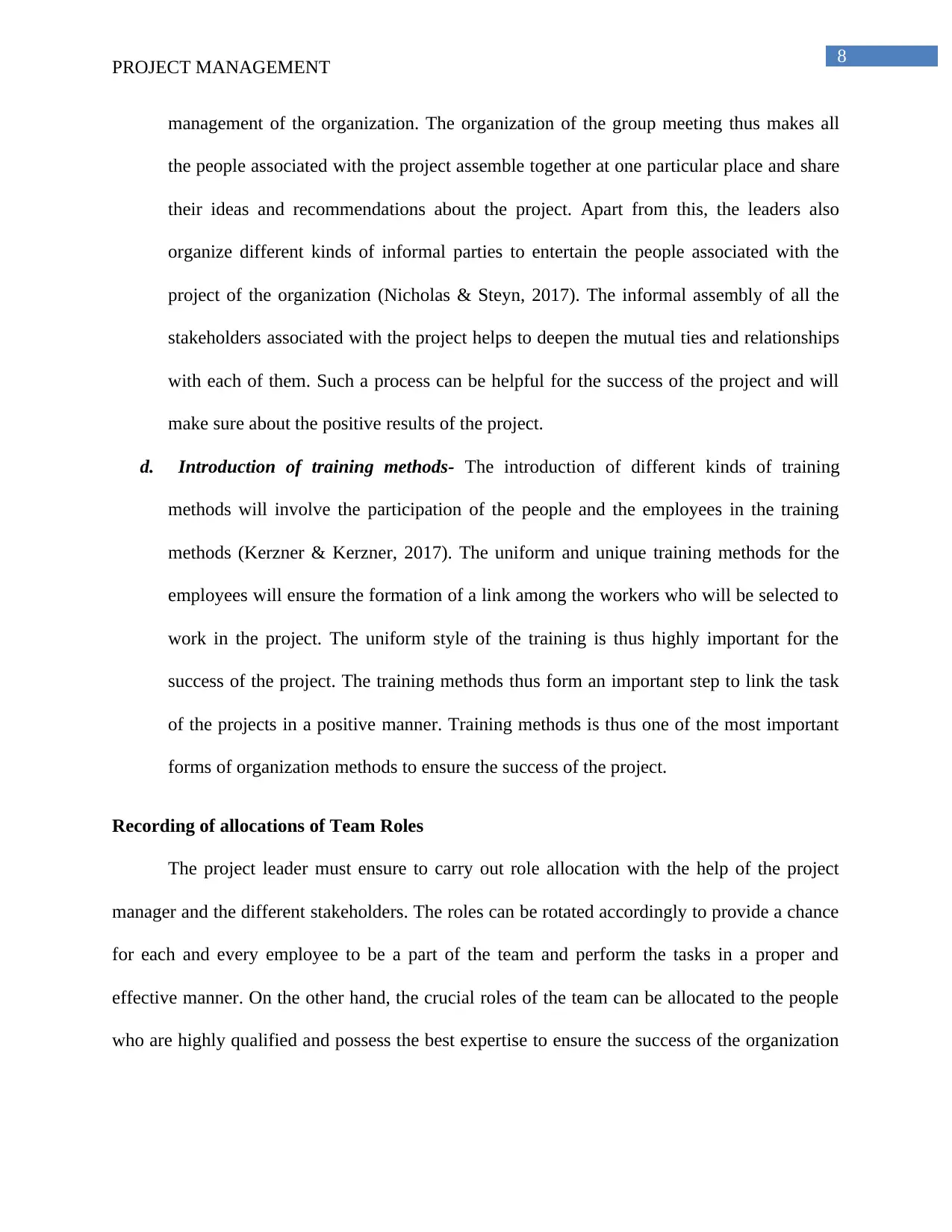
8
PROJECT MANAGEMENT
management of the organization. The organization of the group meeting thus makes all
the people associated with the project assemble together at one particular place and share
their ideas and recommendations about the project. Apart from this, the leaders also
organize different kinds of informal parties to entertain the people associated with the
project of the organization (Nicholas & Steyn, 2017). The informal assembly of all the
stakeholders associated with the project helps to deepen the mutual ties and relationships
with each of them. Such a process can be helpful for the success of the project and will
make sure about the positive results of the project.
d. Introduction of training methods- The introduction of different kinds of training
methods will involve the participation of the people and the employees in the training
methods (Kerzner & Kerzner, 2017). The uniform and unique training methods for the
employees will ensure the formation of a link among the workers who will be selected to
work in the project. The uniform style of the training is thus highly important for the
success of the project. The training methods thus form an important step to link the task
of the projects in a positive manner. Training methods is thus one of the most important
forms of organization methods to ensure the success of the project.
Recording of allocations of Team Roles
The project leader must ensure to carry out role allocation with the help of the project
manager and the different stakeholders. The roles can be rotated accordingly to provide a chance
for each and every employee to be a part of the team and perform the tasks in a proper and
effective manner. On the other hand, the crucial roles of the team can be allocated to the people
who are highly qualified and possess the best expertise to ensure the success of the organization
PROJECT MANAGEMENT
management of the organization. The organization of the group meeting thus makes all
the people associated with the project assemble together at one particular place and share
their ideas and recommendations about the project. Apart from this, the leaders also
organize different kinds of informal parties to entertain the people associated with the
project of the organization (Nicholas & Steyn, 2017). The informal assembly of all the
stakeholders associated with the project helps to deepen the mutual ties and relationships
with each of them. Such a process can be helpful for the success of the project and will
make sure about the positive results of the project.
d. Introduction of training methods- The introduction of different kinds of training
methods will involve the participation of the people and the employees in the training
methods (Kerzner & Kerzner, 2017). The uniform and unique training methods for the
employees will ensure the formation of a link among the workers who will be selected to
work in the project. The uniform style of the training is thus highly important for the
success of the project. The training methods thus form an important step to link the task
of the projects in a positive manner. Training methods is thus one of the most important
forms of organization methods to ensure the success of the project.
Recording of allocations of Team Roles
The project leader must ensure to carry out role allocation with the help of the project
manager and the different stakeholders. The roles can be rotated accordingly to provide a chance
for each and every employee to be a part of the team and perform the tasks in a proper and
effective manner. On the other hand, the crucial roles of the team can be allocated to the people
who are highly qualified and possess the best expertise to ensure the success of the organization
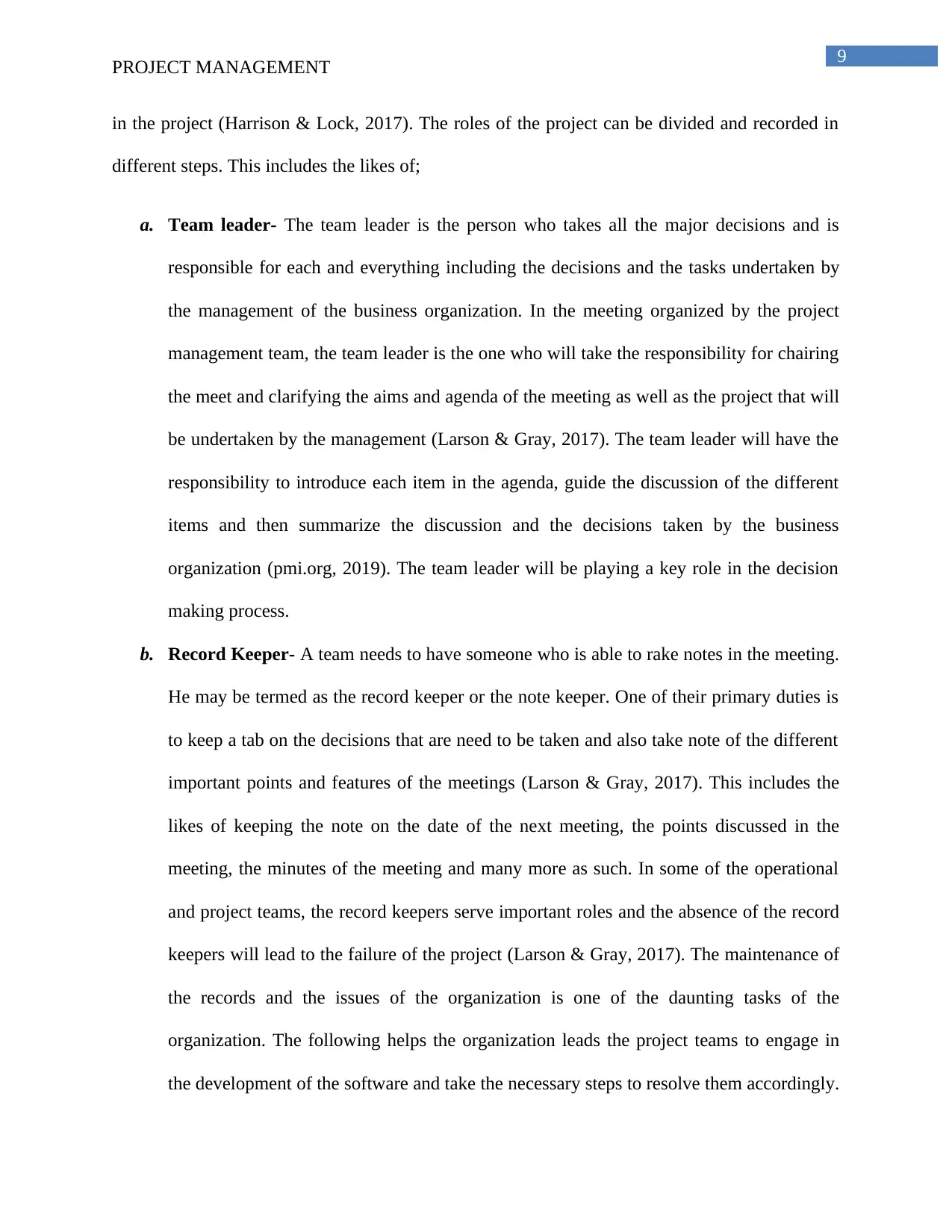
9
PROJECT MANAGEMENT
in the project (Harrison & Lock, 2017). The roles of the project can be divided and recorded in
different steps. This includes the likes of;
a. Team leader- The team leader is the person who takes all the major decisions and is
responsible for each and everything including the decisions and the tasks undertaken by
the management of the business organization. In the meeting organized by the project
management team, the team leader is the one who will take the responsibility for chairing
the meet and clarifying the aims and agenda of the meeting as well as the project that will
be undertaken by the management (Larson & Gray, 2017). The team leader will have the
responsibility to introduce each item in the agenda, guide the discussion of the different
items and then summarize the discussion and the decisions taken by the business
organization (pmi.org, 2019). The team leader will be playing a key role in the decision
making process.
b. Record Keeper- A team needs to have someone who is able to rake notes in the meeting.
He may be termed as the record keeper or the note keeper. One of their primary duties is
to keep a tab on the decisions that are need to be taken and also take note of the different
important points and features of the meetings (Larson & Gray, 2017). This includes the
likes of keeping the note on the date of the next meeting, the points discussed in the
meeting, the minutes of the meeting and many more as such. In some of the operational
and project teams, the record keepers serve important roles and the absence of the record
keepers will lead to the failure of the project (Larson & Gray, 2017). The maintenance of
the records and the issues of the organization is one of the daunting tasks of the
organization. The following helps the organization leads the project teams to engage in
the development of the software and take the necessary steps to resolve them accordingly.
PROJECT MANAGEMENT
in the project (Harrison & Lock, 2017). The roles of the project can be divided and recorded in
different steps. This includes the likes of;
a. Team leader- The team leader is the person who takes all the major decisions and is
responsible for each and everything including the decisions and the tasks undertaken by
the management of the business organization. In the meeting organized by the project
management team, the team leader is the one who will take the responsibility for chairing
the meet and clarifying the aims and agenda of the meeting as well as the project that will
be undertaken by the management (Larson & Gray, 2017). The team leader will have the
responsibility to introduce each item in the agenda, guide the discussion of the different
items and then summarize the discussion and the decisions taken by the business
organization (pmi.org, 2019). The team leader will be playing a key role in the decision
making process.
b. Record Keeper- A team needs to have someone who is able to rake notes in the meeting.
He may be termed as the record keeper or the note keeper. One of their primary duties is
to keep a tab on the decisions that are need to be taken and also take note of the different
important points and features of the meetings (Larson & Gray, 2017). This includes the
likes of keeping the note on the date of the next meeting, the points discussed in the
meeting, the minutes of the meeting and many more as such. In some of the operational
and project teams, the record keepers serve important roles and the absence of the record
keepers will lead to the failure of the project (Larson & Gray, 2017). The maintenance of
the records and the issues of the organization is one of the daunting tasks of the
organization. The following helps the organization leads the project teams to engage in
the development of the software and take the necessary steps to resolve them accordingly.
⊘ This is a preview!⊘
Do you want full access?
Subscribe today to unlock all pages.

Trusted by 1+ million students worldwide
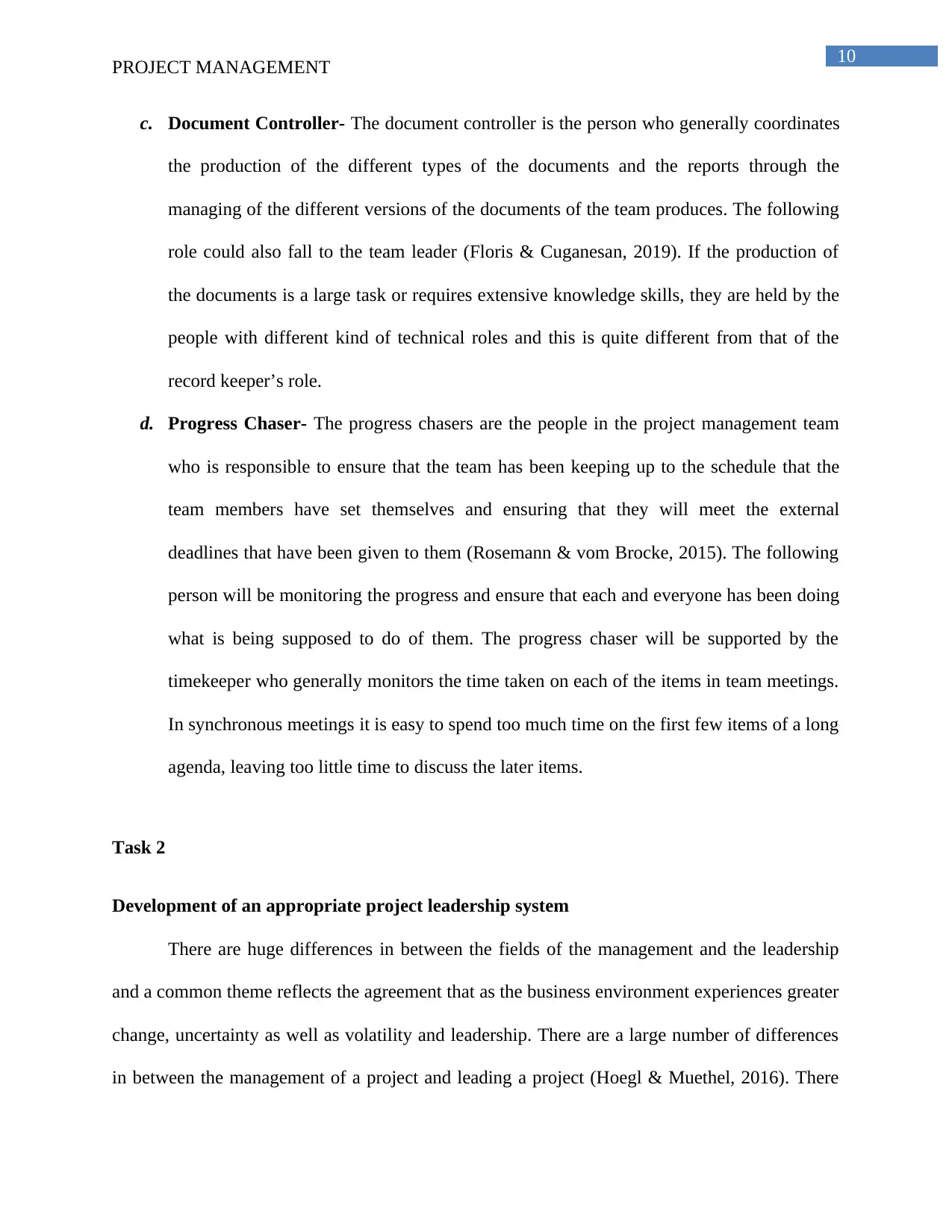
10
PROJECT MANAGEMENT
c. Document Controller- The document controller is the person who generally coordinates
the production of the different types of the documents and the reports through the
managing of the different versions of the documents of the team produces. The following
role could also fall to the team leader (Floris & Cuganesan, 2019). If the production of
the documents is a large task or requires extensive knowledge skills, they are held by the
people with different kind of technical roles and this is quite different from that of the
record keeper’s role.
d. Progress Chaser- The progress chasers are the people in the project management team
who is responsible to ensure that the team has been keeping up to the schedule that the
team members have set themselves and ensuring that they will meet the external
deadlines that have been given to them (Rosemann & vom Brocke, 2015). The following
person will be monitoring the progress and ensure that each and everyone has been doing
what is being supposed to do of them. The progress chaser will be supported by the
timekeeper who generally monitors the time taken on each of the items in team meetings.
In synchronous meetings it is easy to spend too much time on the first few items of a long
agenda, leaving too little time to discuss the later items.
Task 2
Development of an appropriate project leadership system
There are huge differences in between the fields of the management and the leadership
and a common theme reflects the agreement that as the business environment experiences greater
change, uncertainty as well as volatility and leadership. There are a large number of differences
in between the management of a project and leading a project (Hoegl & Muethel, 2016). There
PROJECT MANAGEMENT
c. Document Controller- The document controller is the person who generally coordinates
the production of the different types of the documents and the reports through the
managing of the different versions of the documents of the team produces. The following
role could also fall to the team leader (Floris & Cuganesan, 2019). If the production of
the documents is a large task or requires extensive knowledge skills, they are held by the
people with different kind of technical roles and this is quite different from that of the
record keeper’s role.
d. Progress Chaser- The progress chasers are the people in the project management team
who is responsible to ensure that the team has been keeping up to the schedule that the
team members have set themselves and ensuring that they will meet the external
deadlines that have been given to them (Rosemann & vom Brocke, 2015). The following
person will be monitoring the progress and ensure that each and everyone has been doing
what is being supposed to do of them. The progress chaser will be supported by the
timekeeper who generally monitors the time taken on each of the items in team meetings.
In synchronous meetings it is easy to spend too much time on the first few items of a long
agenda, leaving too little time to discuss the later items.
Task 2
Development of an appropriate project leadership system
There are huge differences in between the fields of the management and the leadership
and a common theme reflects the agreement that as the business environment experiences greater
change, uncertainty as well as volatility and leadership. There are a large number of differences
in between the management of a project and leading a project (Hoegl & Muethel, 2016). There
Paraphrase This Document
Need a fresh take? Get an instant paraphrase of this document with our AI Paraphraser
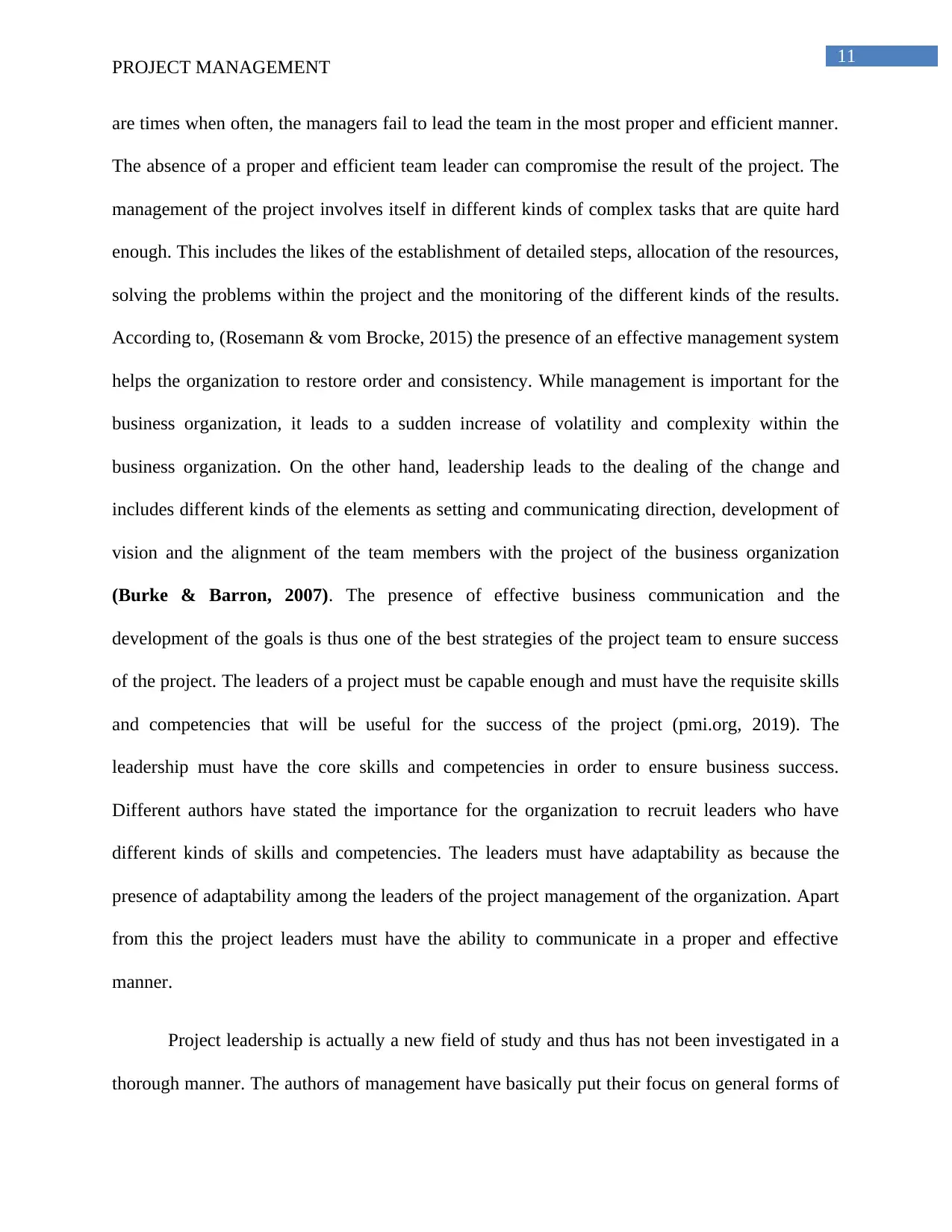
11
PROJECT MANAGEMENT
are times when often, the managers fail to lead the team in the most proper and efficient manner.
The absence of a proper and efficient team leader can compromise the result of the project. The
management of the project involves itself in different kinds of complex tasks that are quite hard
enough. This includes the likes of the establishment of detailed steps, allocation of the resources,
solving the problems within the project and the monitoring of the different kinds of the results.
According to, (Rosemann & vom Brocke, 2015) the presence of an effective management system
helps the organization to restore order and consistency. While management is important for the
business organization, it leads to a sudden increase of volatility and complexity within the
business organization. On the other hand, leadership leads to the dealing of the change and
includes different kinds of the elements as setting and communicating direction, development of
vision and the alignment of the team members with the project of the business organization
(Burke & Barron, 2007). The presence of effective business communication and the
development of the goals is thus one of the best strategies of the project team to ensure success
of the project. The leaders of a project must be capable enough and must have the requisite skills
and competencies that will be useful for the success of the project (pmi.org, 2019). The
leadership must have the core skills and competencies in order to ensure business success.
Different authors have stated the importance for the organization to recruit leaders who have
different kinds of skills and competencies. The leaders must have adaptability as because the
presence of adaptability among the leaders of the project management of the organization. Apart
from this the project leaders must have the ability to communicate in a proper and effective
manner.
Project leadership is actually a new field of study and thus has not been investigated in a
thorough manner. The authors of management have basically put their focus on general forms of
PROJECT MANAGEMENT
are times when often, the managers fail to lead the team in the most proper and efficient manner.
The absence of a proper and efficient team leader can compromise the result of the project. The
management of the project involves itself in different kinds of complex tasks that are quite hard
enough. This includes the likes of the establishment of detailed steps, allocation of the resources,
solving the problems within the project and the monitoring of the different kinds of the results.
According to, (Rosemann & vom Brocke, 2015) the presence of an effective management system
helps the organization to restore order and consistency. While management is important for the
business organization, it leads to a sudden increase of volatility and complexity within the
business organization. On the other hand, leadership leads to the dealing of the change and
includes different kinds of the elements as setting and communicating direction, development of
vision and the alignment of the team members with the project of the business organization
(Burke & Barron, 2007). The presence of effective business communication and the
development of the goals is thus one of the best strategies of the project team to ensure success
of the project. The leaders of a project must be capable enough and must have the requisite skills
and competencies that will be useful for the success of the project (pmi.org, 2019). The
leadership must have the core skills and competencies in order to ensure business success.
Different authors have stated the importance for the organization to recruit leaders who have
different kinds of skills and competencies. The leaders must have adaptability as because the
presence of adaptability among the leaders of the project management of the organization. Apart
from this the project leaders must have the ability to communicate in a proper and effective
manner.
Project leadership is actually a new field of study and thus has not been investigated in a
thorough manner. The authors of management have basically put their focus on general forms of
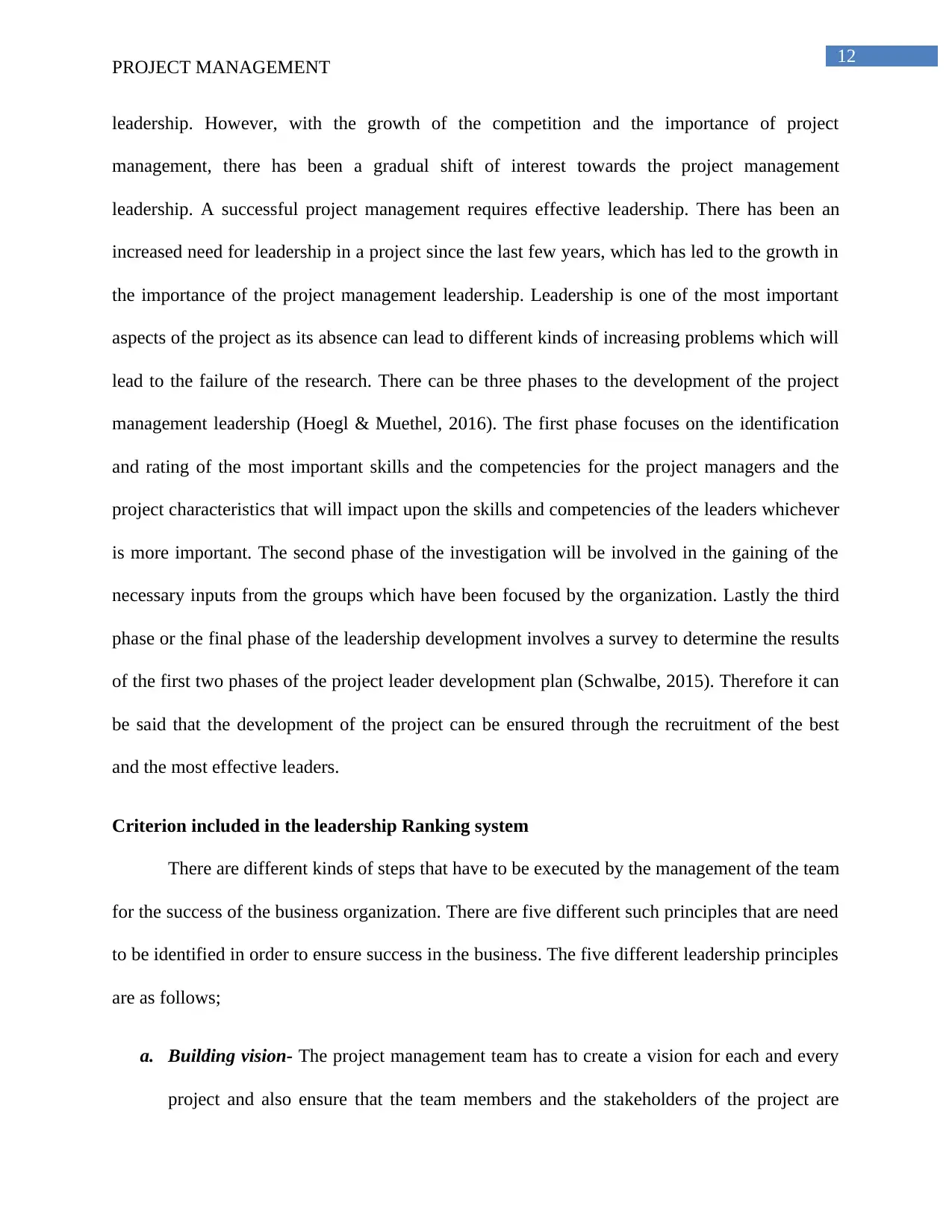
12
PROJECT MANAGEMENT
leadership. However, with the growth of the competition and the importance of project
management, there has been a gradual shift of interest towards the project management
leadership. A successful project management requires effective leadership. There has been an
increased need for leadership in a project since the last few years, which has led to the growth in
the importance of the project management leadership. Leadership is one of the most important
aspects of the project as its absence can lead to different kinds of increasing problems which will
lead to the failure of the research. There can be three phases to the development of the project
management leadership (Hoegl & Muethel, 2016). The first phase focuses on the identification
and rating of the most important skills and the competencies for the project managers and the
project characteristics that will impact upon the skills and competencies of the leaders whichever
is more important. The second phase of the investigation will be involved in the gaining of the
necessary inputs from the groups which have been focused by the organization. Lastly the third
phase or the final phase of the leadership development involves a survey to determine the results
of the first two phases of the project leader development plan (Schwalbe, 2015). Therefore it can
be said that the development of the project can be ensured through the recruitment of the best
and the most effective leaders.
Criterion included in the leadership Ranking system
There are different kinds of steps that have to be executed by the management of the team
for the success of the business organization. There are five different such principles that are need
to be identified in order to ensure success in the business. The five different leadership principles
are as follows;
a. Building vision- The project management team has to create a vision for each and every
project and also ensure that the team members and the stakeholders of the project are
PROJECT MANAGEMENT
leadership. However, with the growth of the competition and the importance of project
management, there has been a gradual shift of interest towards the project management
leadership. A successful project management requires effective leadership. There has been an
increased need for leadership in a project since the last few years, which has led to the growth in
the importance of the project management leadership. Leadership is one of the most important
aspects of the project as its absence can lead to different kinds of increasing problems which will
lead to the failure of the research. There can be three phases to the development of the project
management leadership (Hoegl & Muethel, 2016). The first phase focuses on the identification
and rating of the most important skills and the competencies for the project managers and the
project characteristics that will impact upon the skills and competencies of the leaders whichever
is more important. The second phase of the investigation will be involved in the gaining of the
necessary inputs from the groups which have been focused by the organization. Lastly the third
phase or the final phase of the leadership development involves a survey to determine the results
of the first two phases of the project leader development plan (Schwalbe, 2015). Therefore it can
be said that the development of the project can be ensured through the recruitment of the best
and the most effective leaders.
Criterion included in the leadership Ranking system
There are different kinds of steps that have to be executed by the management of the team
for the success of the business organization. There are five different such principles that are need
to be identified in order to ensure success in the business. The five different leadership principles
are as follows;
a. Building vision- The project management team has to create a vision for each and every
project and also ensure that the team members and the stakeholders of the project are
⊘ This is a preview!⊘
Do you want full access?
Subscribe today to unlock all pages.

Trusted by 1+ million students worldwide
1 out of 20
Related Documents
Your All-in-One AI-Powered Toolkit for Academic Success.
+13062052269
info@desklib.com
Available 24*7 on WhatsApp / Email
![[object Object]](/_next/static/media/star-bottom.7253800d.svg)
Unlock your academic potential
Copyright © 2020–2025 A2Z Services. All Rights Reserved. Developed and managed by ZUCOL.





